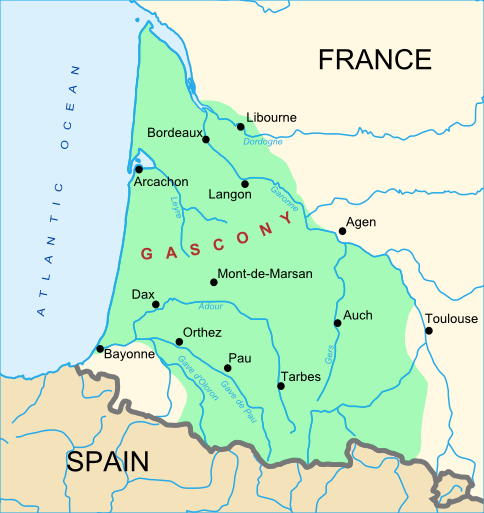|
Arrufiac
Arrufiac (or Arrufiat) is a white French wine grape varietyArrufiac , accessed on June 26, 2010 that is primarily planted in the region of South West France. It is a secondary grape in the wines from the Pacherenc du Vic-Bilh '' |
Madiran (wine)
Madiran wine is produced around the village of Madiran in Gascony under three '' Appellations d'Origine Contrôlées'' (AOCs): Madiran for red wines and Pacherenc du Vic-Bilh and Pacherenc du Vic-Bilh Sec for white wines. The production area for Madiran wine is spread over three '' départments'' – Gers, Hautes-Pyrénées and Pyrénées-Atlantiques – and is a part of the South West France wine region. There are of Madiran vineyards.CIVSO: AOC MADIRAN carte d'identité accessed on May 17, 2008 Madiran AOC Madiran was created as an AOC in 1948, and only red wine can be produced under this appellation. The main grape variety in Madiran AOC is |
Pacherenc Du Vic-Bilh
Madiran wine is produced around the village of Madiran in Gascony under three '' Appellations d'Origine Contrôlées'' (AOCs): Madiran for red wines and Pacherenc du Vic-Bilh and Pacherenc du Vic-Bilh Sec for white wines. The production area for Madiran wine is spread over three '' départments'' – Gers, Hautes-Pyrénées and Pyrénées-Atlantiques – and is a part of the South West France wine region. There are of Madiran vineyards.CIVSO: AOC MADIRAN carte d'identité accessed on May 17, 2008 Madiran AOC Madiran was created as an AOC in 1948, and only red wine can be produced under this appellation. The main grape variety in Madiran AOC is Tannat[...More Info...] [...Related Items...] OR: [Wikipedia] [Google] [Baidu] |
Grape Variety
This list of grape varieties includes cultivated grapes, whether used for wine, or eating as a table grape, fresh or dried (raisin, currant, sultana). For a complete list of all grape species including those unimportant to agriculture, see Vitis. The term ''grape variety'' refers to cultivars rather than actual botanical varieties according to the International Code of Nomenclature for Cultivated Plants, because they are propagated by cuttings and may have unstable reproductive properties. However, the term ''variety'' has become so entrenched in viticulture that any change to using the term ''cultivar'' instead is unlikely. Single species grapes While some of the grapes in this list are hybrids, they are hybridized within a single species. For those grapes hybridized across species, known as interspecific hybrids, see the section on multispecies hybrid grapes below. ''Vitis vinifera'' (wine) Red grapes White grapes Rose Grapes ''Vitis vinifera'' (table) ... [...More Info...] [...Related Items...] OR: [Wikipedia] [Google] [Baidu] |
South West France (wine)
South West France, or in French ''Sud-Ouest'', is a wine region in France covering several wine-producing areas situated respectively inland from, and south of, the wine region of Bordeaux. accessed on February 23, 2008 These areas, which have a total of 16,000 s (40,000 s) of vineyards, consist of several discontinuous wine "islands" throughout the region (where Bordeaux region itself is situated), and more or less to the west of ... [...More Info...] [...Related Items...] OR: [Wikipedia] [Google] [Baidu] |
Vitis Vinifera
''Vitis vinifera'', the common grape vine, is a species of flowering plant, native to the Mediterranean region, Central Europe, and southwestern Asia, from Morocco and Portugal north to southern Germany and east to northern Iran. There are currently between 5,000 and 10,000 varieties of ''Vitis vinifera'' grapes though only a few are of commercial significance for wine and table grape production. The wild grape is often classified as ''Vitis vinifera'' ''sylvestris'' (in some classifications considered ''Vitis sylvestris''), with ''Vitis vinifera'' ''vinifera'' restricted to cultivated forms. Domesticated vines have hermaphrodite flowers, but ''sylvestris'' is dioecious ( male and female flowers on separate plants) and pollination is required for fruit to develop. Grapes can be eaten fresh or dried to produce raisins, sultanas, and currants. Grape leaves are used in the cuisine of many cultures. The fresh grapes can also be processed into juice that is fermented to make ... [...More Info...] [...Related Items...] OR: [Wikipedia] [Google] [Baidu] |
Body (wine)
The use of wine tasting descriptors allows the taster to qualitatively relate the aromas and flavors that the taster experiences and can be used in assessing the overall quality of wine. Wine writers differentiate wine tasters from casual enthusiasts; tasters attempt to give an objective description of the wine's taste (often taking a systematic approach to tasting), casual enthusiasts appreciate wine but pause their examination sooner than tasters. The primary source of a person's ability to taste wine is derived from their olfactory senses. A taster's own personal experiences play a significant role in conceptualizing what they are tasting and attaching a description to that perception. The individual nature of tasting means that descriptors may be perceived differently among various tasters. The following is an incomplete list of wine tasting descriptors and a common meaning of the terms. These terms and usage are from Karen MacNeil's 2001 edition of ''The Wine Bible'' un ... [...More Info...] [...Related Items...] OR: [Wikipedia] [Google] [Baidu] |
Gros Manseng
Gros Manseng (sometimes translated: Large Manseng, rarely "Big Manseng") is a white wine grape variety that is grown primarily in South West France, and is part of the Manseng family. It produces dry wines in the Jurançon and Béarn regions of Southwest France. In Gascony it is permitted in the Pacherenc du Vic-Bilh ''Appellation d'origine contrôlée'' (AOC), in the Côtes de Gascogne and in the Floc de Gascogne. Comparison to Petit Manseng While the grape vines of Gros Manseng and Petit Manseng look very similar to each other, there are distinct differences. Gros Manseng's berries are larger and less susceptible to coulure. The vine also produces much higher yields but the resulting wine is less elegant and rich than wine made from Petit Manseng.J. Robinson (ed) ''"The Oxford Companion to Wine"'' Third Edition pg 334 Oxford University Press 2006 Wine styles On its own, Gros Manseng has the potential to produce intensely flavored wines with high acidity, apricot a ... [...More Info...] [...Related Items...] OR: [Wikipedia] [Google] [Baidu] |
Petit Manseng
Petit Manseng (sometimes translated: Small Manseng, rarely "Little Manseng") is a white wine grape variety that is grown primarily in South West France. It produces the highest quality wine of any grape in the Manseng family. The name is derived from its small, thick skin berries. Coupled with the small yields of the grapevine, most Petit Manseng farmers produce around 15 hl of wine per hectare. The grape is often left on the vine till December to produce a late harvest dessert wine. The grape is grown primarily in Gascony, Jurançon and around Madiran (for Pacherenc du Vic-Bilh) but has recently drawn interest in New World wine regions like California, North Georgia, Virginia, and Ohio. In May 2020, CSIRO scientists discovered through DNA analysis that Australia's plantings of Petit Manseng, first imported in 1979, are in fact Gros Manseng. The reason is that it is expected to follow Viognier's path to popularity among white wine drinkers. J. Robinson (ed) ''"The Oxford C ... [...More Info...] [...Related Items...] OR: [Wikipedia] [Google] [Baidu] |
Jurançon (AOC)
Jurançon (; oc, Juranson) is a commune in the Pyrénées-Atlantiques department in Nouvelle-Aquitaine, France. Population See also *Jurançon AOC, a wine from this commune *Communes of the Pyrénées-Atlantiques department The following is a list of the 546 communes of the Pyrénées-Atlantiques department of France. The communes cooperate in the following intercommunalities (as of 2020):Communes of Pyrénées-Atlantiques {{PyrénéesAtlantiques-geo-stub ... [...More Info...] [...Related Items...] OR: [Wikipedia] [Google] [Baidu] |
Aroma (wine)
The aromas of wine are more diverse than its flavours. The human tongue is limited to the primary tastes perceived by taste receptors on the tongue – sourness, bitterness, saltiness, sweetness and savouriness. The wide array of fruit, earthy, leathery, floral, herbal, mineral, and woodsy flavour present in wine are derived from aroma notes sensed by the olfactory bulb.J. Robinson (ed) ''"The Oxford Companion to Wine"'' Third Edition p. 683 Oxford University Press 2006 In wine tasting, wine is sometimes smelled before taking a sip in order to identify some components of the wine that may be present. Different terms are used to describe what is being smelled. The most basic term is aroma which generally refers to a "pleasant" smell as opposed to odour which refers to an unpleasant smell or possible wine fault. The term aroma may be further distinguished from bouquet which generally refers to the smells that arise from the chemical reactions of fermentation and aging ... [...More Info...] [...Related Items...] OR: [Wikipedia] [Google] [Baidu] |
Gunflint
Flint, occasionally flintstone, is a sedimentary cryptocrystalline form of the mineral quartz, categorized as the variety of chert that occurs in chalk or marly limestone. Flint was widely used historically to make stone tools and start fires. It occurs chiefly as nodules and masses in sedimentary rocks, such as chalks and limestones.''The Flints from Portsdown Hill'' Inside the nodule, flint is usually dark grey, black, green, white or brown in colour, and often has a glassy or waxy appearance. A thin layer on the outside of the nodules is usually different in colour, typically white and rough in texture. The nodules can often be found along s and |






